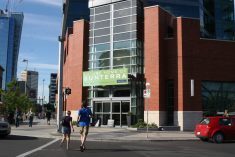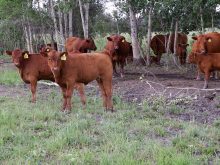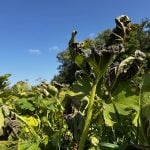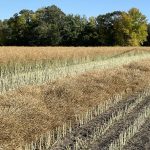Alberta has a good water management foundation, but enhancements are needed to ensure the province can handle future growth demands.
Those are the conclusions of a recent report presented to the provincial environment minister and released in November on long-term water sustainability and allocation of Alberta’s water.
Two other reports from the Alberta Water Council and Alberta Water Research Institute have also recommended ways to better allocate water for social, environmental and economic needs.
Water management has been an issue since the first irrigation act was passed in 1894 and little has changed since, said University of Alberta water lawyer David Percy, who chaired the minister’s advisory group on recommendations for improving Alberta’s water management and allocation.
Read Also

Trade war may create Canadian economic opportunities
Canada’s current tariff woes could open chances for long-term economic growth and a stronger Canadian economy, consultant says — It’s happened before.
“It has been controversial since day one,” he said.
The report offered 11 recommendations, including the concept of protected water. For example, the South Saskatchewan River basin has a water conservation objective of 45 percent of natural flow and full allocation for the remainder.
The committee said a provincial conservation objective should be placed on every river to prevent future problems of full allocation.
Percy favours water transfers among existing licence holders because no new licences are allowed on the South Saskatchewan River basin.
About 40 transfers have occurred successfully with little fanfare since 2002. They were allowed under the 1999 water act that Percy helped craft.
A major question for the committee was how to fairly distribute water when a licensee has more than could be possibly used.
The water act prohibits arbitrary sharing. Instead, those needing water approach a licensee to see if they are willing to sell and share.
“It actually encourages us to make more out of our existing supply of water,” he said.
The best way to accommodate new business is for farmers or urban municipalities to conserve water and then sell the balance.
“If you don’t go for market transfers, then the government would have to step in and take it, which few would support,” Percy said.
However, the logistics of these kinds of transfers are cumbersome.
“Most of those minor agriculture transfers that happened were totally noncontroversial and could be approved very quickly. We should only have a long drawn out process when there is a very serious transfer that affects the environment,” he said.
Water allocations can be sold for one year or as part of a larger, more permanent agreement.
Permanent transfers have considerable costs and conditions under Alberta’s environment regulations, and the government has the right to claw back 10 percent of the water.
“In every transaction so far, they have taken the 10 percent, so the buyer and the seller have found this tax to be a little bit high,” said University of Lethbridge economist Kurt Klein.
“There is resentment about that.”
On the other hand, Percy argues that this tax encourages conservation.
Klein is working on a large multi-disciplinary study of the socio-economic impacts of water allocation, marketing and conflicts that may occur when further demands are placed on the Alberta water supply.
The impacts of a water market entered the public debate when the Western Irrigation District made a water deal with a mall developer east of Calgary.
The local municipality told the developer it could not proceed with the $1 billion project until adequate water was found. The district was paid $15 million for water and modernized its facilities to prevent evaporation and seepage losses. The conserved water was then turned over to the municipality to service the mall.
“There will likely be the need for more of these kinds of water transactions in the future,” Klein said.
The U of L project hopes to find ways to reduce conflict between user groups. Klein is looking at how these conflicting demands affect agriculture production.
“As the economy grows with no new water for allocation, new users will have to get their water needs supplied by existing water licence holders,” he said.
Irrigation districts and the City of Calgary hold large licences far beyond what they use. Klein worries more new users will demand a share of agriculture’s allocation.
He wants to determine how limits on agricultural water use would affect farm income, crop production and asset values of farms.
“Farming is quite a difficult business and it is easy to say ‘get water from the farmers,’ but this could have quite big impacts on our ability to produce food efficiently,” he said.
A market system is an efficient way to allocate resources, including water, but Klein said there is little experience in making it work in Canada. The country has no auction or other mechanism to organize buyers and sellers as is done in other countries.
The new buyers might be food processing firms, biofuel plants, malls, rural and urban municipalities, suburban developments, recreation or private irrigators.
Environmental lobbies are raising objections to buying and selling water. They believe it should be confiscated, which also creates conflict.
“Moving water around is not as simple as buying a television set because it affects other people,” he said.
Dams, dikes & gates: a glossary
Reservoirs store and control primary water supplies for irrigation. In Alberta, most of the stored water is from spring snowmelt. The stored water may back into a natural coulee, valley or lake that is usually enlarged for extra capacity. Reservoirs may be built on-stream or off-stream.
Dams in Alberta are earthen or rock filled. Diversion structures direct water from a reservoir into the stream or diversion canal. Spillways protect the reservoir embankments and irrigation structures, and control the flow of flood waters.
Border dikes make surface or flood irrigation more efficient. Water is supplied from a delivery ditch at the upper end of a graded field, using syphons or turnouts. Excess water is collected at the lower end of the field, then channeled to a return flow. The fields are usually levelled to follow a downslope of less than 2 per cent to decrease erosion.
Return flow channels carry excess irrigation water back to a river or reservoir. They can include natural drainage systems or man-made canals.
Drop structures placed at intervals along a channel stabilize it by changing its profile from a continuous steep gradient to a series of more gently sloping reaches.
Pipelines can be used to replace surface canals and to bring water from the canals to farm pivots. They are usually located underground.
Check structures are built into canals to raise and hold water at a specific level and facilitate upstream delivery.
Turnouts are used to divert water from a canal or other supply source. Multi-piped turnouts with motorized and computer-controlled gates are used to divert larger amounts of water. On-farm turnouts may be only gated culverts.
Gates are used to open and close turnouts and other diversion structures. Trash screens are often used to keep gates from clogging.
Source: Irrigation in Alberta, Alberta Agriculture














